CRI Research

POLICY REPORT | March 2025
A State-Level Analysis of Who Lacks Access to Retirement Savings and an Examination of the Potential Benefits of State-Facilitated Retirement Savings Programs
This report provides a national and 51 state-level (including DC) analysis of retirement access to employer-sponsored plans in the United States. The analysis reveals significant gaps in retirement plan access while demonstrating how state-facilitated retirement savings programs can effectively expand coverage for millions of Americans. Other state specific metrics, such as demographic trends related to the aging of the population, the economic and fiscal benefits to the state of adding new savers, and the projected growth in savings and retirement income for an auto-IRA saver eligible for the new Saver’s Match, are included. (View State-by-State Interactive Map). The report also examines the direct and indirect contributions of 3 state programs – CalSavers, Illinois Secure Choice and OregonSaves – to expanding access to retirement savings for workers in each of their states. (View Early Adopter State Profiles).
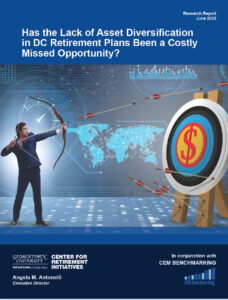
RESEARCH REPORT | June 2023
Has the Lack of Asset Diversification in DC Retirement Plans Been a Costly Missed Opportunity?
The analysis focuses on the period 2011–2020 and assesses how DC plan participants’ experiences would have changed had DC TDFs made higher allocations to illiquid assets during that time. The report concludes that the amount by which returns would have increased would have generated $5 billion per year in additional net return if this change had been applied to the entire U.S. TDF universe. Using reasonable assumptions for an individual DC participant who saves for 40 years and then draws down for 20, the return improvement might represent an additional $2,400 per year ($200 per month) in spending power in retirement for a retiree already drawing $4,000 per month or $48,000 per year in retirement income.

REPORT | DECEMBER 2022
Can Asset Diversification & Access to Private Markets Improve Retirement Income Outcomes?
This report highlights new updated analysis showing how even modest asset diversification in target date funds (TDFs) can improve long-term expected retirement income for individuals (net of fees) by between 8 and 6 percent with the inclusion of alternative assets. Operational issues, such as liquidity, pricing, etc. can be easily addressed today. Policymakers and plan sponsors should consider the inclusion of alternative assets classes in DC plans. Expanding the TDF opportunity set to include a wider and more diverse selection of asset classes can help drive greater returns and improved income outcomes for millions of U.S. workers.
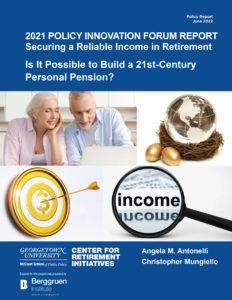
POLICY REPORT | JUNE 2022
2021 Policy Innovation Forum Report | Securing a Reliable Income in Retirement: Is It Possible to Build a 21st-Century Personal Pension?
On November 2–3, 2021, the CRI convened an exclusive, invitation-only annual Policy Innovation Forum virtual event with select U.S. and international thought leaders to discuss the challenges of designing retirement solutions for generating and securing reliable lifetime income. The Forum examined the considerations and solutions for mitigating major risks to retirement income — e.g., longevity, timing, investment, inflation, etc. — and the experiences of other nations with lessons for the United States. This report summarizes the key takeaways and ideas discussed, and highlights research papers chosen in a Forum-related Call for Papers.
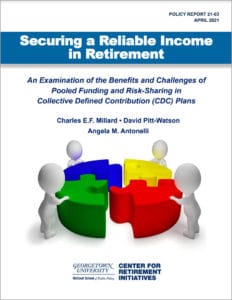
Policy Report 21-03 | April 2021
Securing a Reliable Income in Retirement: An Examination of the Benefits and Challenges of Pooled Funding and Risk-Sharing in Collective Defined Contribution (CDC) Plans
Private sector workers in the United States continue to struggle to find a cost-effective way of securing a reliable income in retirement. The US is not alone in facing this challenge. In both the Netherlands, and most recently now in the United Kingdom (UK), collective defined contribution (CDC) plans are being used to provide lifetime income. Recent studies of CDC plan experience in Europe suggest that a CDC plan can be simple and low-cost in design and generate a retirement income at least 30% higher than a typical DC plan. This paper reviews the benefits, risks, and challenges in CDC plans based on experiences in the Netherlands and the UK, and concludes with some lessons for US.
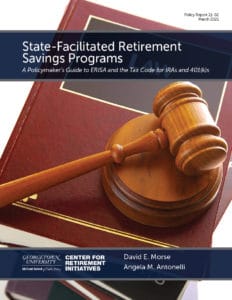
Policy Report 21-02 | March 2021
State-Facilitated Retirement Savings Programs: A Policymaker’s Guide to ERISA and the Tax Code for IRAs and 401(k)s
This paper provides policymakers with a primer about ERISA and the Tax Code, how these federal laws and their regulations pertain to IRAs and 401(k)s, and what this means for state-facilitated retirement savings programs. After reviewing the question of ERISA applicability to state auto-IRAs and an overview of the federal Tax Code and IRA rules, it explores how ERISA and the Tax Code rules apply to 401(k)s, including the new rules allowing states (and others) to possibly lower 401(k) costs by sponsoring group 401(k)MEPs and PEPs.
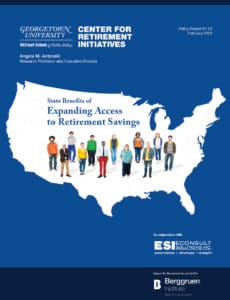
Policy Report 21-01 | February 2021
State Benefits of Expanding Access to Retirement Savings
Note: This report has since been updated. View Policy Report 2025-01, March 2025. This report provides state-level analysis of the benefits of expanding worker access to save for retirement through state-facilitated auto-IRA programs. This report is derived from CRI’s earlier research on the potential benefits of national universal access to retirement savings options for U.S. workers (See Policy Report 20-02).

Policy Report 20-02 | December 2020
What Are the Potential Benefits of Universal Access to Retirement Savings? An Analysis of National Options to Expand Coverage
This report analyzes the potential benefits of national universal access to retirement savings options for U.S. workers. It examines how characteristics such as account type (payroll deduction IRA vs. 401(k)), the employers required to participate, and default levels of employee contributions and any employer contributions will drive access, savings, asset growth, and retirement income over time. The economic and fiscal benefits of a national approach to universal access is enormous, contributing to significant growth in GDP and reduced federal and state spending on benefit programs for the elderly. This report draws from the experience of other countries and from the early state-facilitated retirement programs in the U.S. to make the case that universal access to retirement savings options can be achieved in a simple, cost-effective manner with private market providers ready to compete to offer options for workers. (Methodology Appendix)
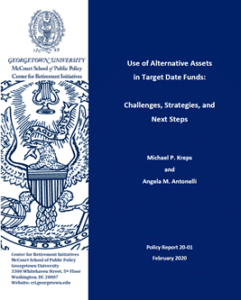
Policy Report 20-01 | February 2020
Use of Alternative Assets in Target Date Funds: Challenges, Strategies, and Next Steps
This report describes the potential benefits that allocation to alternative assets could offer a TDF’s investment portfolio, including enhanced retirement income for participants, with some case study considerations and international examples. It identifies and explains the unique challenges a fiduciary should consider when deciding to include alternatives in a TDF, as well as appropriate strategies a fiduciary may use to apply appropriate due diligence. Finally, to support and encourage this innovation, the report recommends action by DOL to clarify a fiduciary’s responsibility when including alternatives in TDFs.

Policy Report 19-02 | June 2019
Generating and Protecting Retirement Income in Defined Contribution Plans: An Analysis of How Different Solutions Address Participant Needs
This report analyzes how different lifetime income solutions can help retirees meet their lifetime income needs. It examines several options to determine how well they achieve different objectives for retirement income including stability, maximization, longevity protection, growth potential, asset preservation, cost and liquidity. It highlights the growing demand for lifetime income solutions and the need for policymakers and plan sponsors to begin to integrate these solutions into retirement plans as more plan participants come to expect their DC plans to help generate and protect income for retirement.
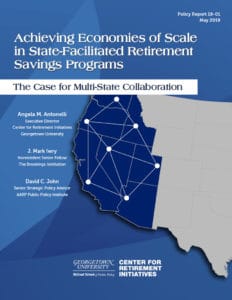
Policy Report 19-01 | May 2019
Achieving Economics of Scale in State-Facilitated Retirement Savings Programs: The Case for Multi-State Collaboration
This final report updates and replaces CRI Working Paper 18-02, published in June 2018. This report outlines several models, based on a multi-state or regional approach, that should be explored for how states can work together to serve more than one state. Although individual states can establish their own state-sponsored retirement savings programs, the consideration of interstate arrangements offers opportunities for states to explore how they can achieve economies of scale to help minimize costs while significantly expanding access to retirement savings options.
